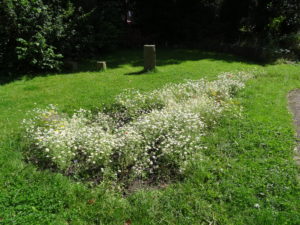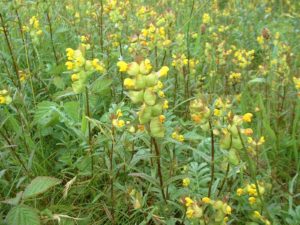Whether it’s a flowerpot or an entire meadow, planting wildflowers supports a wide range of insects that couldn’t survive in urban areas otherwise.
Option 1 – Let your grass grow long
Long grass, peppered with flowers, is incredibly beneficial for wildlife. Patches of long grass encourage different plant species to grow, help insects to thrive, provide food for birds, and shelter small mammals.
So simply let nature move in! Set aside some lawn, leave it to grow, and wait to see what arrives. The less pristine the lawn, the better it is for wildlife. If you want to make it look more “looked after”, just raise the cutters on your mower to make some paths and leave the rest of the mowing until July or August after plants have flowered.
Option 2 – Start from scratch
You can create a wildflower area from scratch on bare ground. Pick a low-nutrient patch of ground that hasn’t been cultivated recently; wildflower meadows establish best on unproductive soil. It’s worth checking what sort of soil you have and its pH before you choose which seeds to sow; wildflower seed merchants supply mixes suitable for various soil types and situations. For example, see the excellent advice here and here.
Soil fertility is also key and can also be tested in advance e.g. by NRN laboratories . A phosphorous Index of 0 or 1 is required to restore or create wildflower grassland. It is not advised to undertake wildflower grassland restoration or recreation if the index is higher than 3.
If your soil fertility is too high for perennial wildflowers to flourish, consider sowing a cornfield annual mix that includes plants like cornflower, corn poppy, corn marigold and corncockle, with some barley and wheat seed to add an authentic touch. If the phosphorous index is 2-3 there is the possibility of stripping soil nutrients through management that may create suitable conditions for restoration or creation, or the use of a reduced suite of wildflowers that may be able to compete with the grasses and nutrient-lowing flowers. However, you can also use yellow rattle and cut and collect to reduce fertility over a period of time (see below).
Top tips to create your patch from scratch:
- The more ground preparation you can do, the better the results will be.
- Control weeds by digging or rotovating, burying any vegetation to a depth of 15-20 cm (6-8 in). This also brings less fertile soil to the surface.
- Meadows should not be sown on areas containing large numbers of strong perennial weeds such as docks, nettles or thistles. Sowing into bare ground is always best and it is essential to eliminate such weed species from the proposed meadow area prior to sowing.
- Eradication is best undertaken when the weed species are in rapid, active growth by raking or pulling up by hand. April/May is the most effective time to do this.
- If sowing into grass or an established meadow make sure the grass/meadow is as low as possible.
- You can also dig out existing turf in a lawn/amenity grassland area to create a wildflower ‘bed’ – we have done this at our Victoria Hall office and it worked!

- The most important principle in establishing a wildflower meadow is not to use manure or fertiliser. Wildflowers prefer low-nutrient soil; adding fertiliser can encourage grasses to grow vigorously, which then swamps the wildflowers.
- Firm and rake the surface to make a seedbed.
- Sow in autumn, giving the seed time to settle in over winter. However, you can sow in spring and it is better if you are on heavy clay. Even large areas can be sown by hand quite easily.
- Ensure that the seed is scattered evenly by sowing half lengthways and the remaining half widthways across the plot. Mixing the seed with silver sand makes the process easier. Rake in lightly and water thoroughly.
- If you are concerned about vigorous grasses returning, or not being able to remove them in the first place, consider planting yellow rattle seed in August or September, available from reputable suppliers – we recommend Emorsgate or Naturescape. Yellow rattle is semi-parasitic and will reduce the growth of grass species found in most lawns/amenity grasslands, which allows finer grasses and herbs to flourish. It is also a lovely flower.

Neil Wyatt
Maintaining your wild patch
It’s important not to miss out this last step. Keeping soil nutrient levels low is essential for a successful wildflower meadow. It could take 2-3 years for the meadow to properly establish.
An aesthetically pleasing meadow
Unmown meadows can be seen by some people as ‘unkempt’ grass, especially on public land or outside the peak flowering season. Here are a few ways to spread the “no mow” message:
• Regularly mow a thin strip along the edge (as you would a lawn), especially if by a footpath or car park. This helps give the impression that the site is being managed and is not just ‘waste ground’.
• Do what you can to ensure perennial weeds and grasses don’t proliferate.
• Ensure the meadow is cut annually at the end of the flowering season and remove clippings so the meadow looks neat all through autumn/winter.
Top tips for getting your wild patch right
- Be careful when mowing – small mammals, amphibians and reptiles may be hiding in the grass. Some birds nest in larger meadows, so don’t mow until after the beginning of August.
- Wildflowers are available in plug form and in ready-planted turf rolls, which can make establishing the plants even easier.
- Sow a mix of wild grass and wild flower seed.
Suggested native wild flowers and grasses for Sheffield and Rotherham (n.b. Eastern Rotherham has a different underlying geology and so a limestone species list would be more appropriate instead)
- Autumn hawkbit Leontodon autumnalis
- Bird’s-foot-trefoil Lotus corniculatus
- Black knapweed Centaurea nigra
- Black medic Medicago lupulina
- Bulbous Buttercup Bulbous Buttercup
- Chamomile Chamaemelum nobile
- Common Knapweed Centaurea nigra
- Common sorrel Rumex acetosa (taller) or Sheep sorrel Rumex acetosella (shorter)
- Common Spotted-orchid Dactylorhiza fuchsii
- Common toadflax Linaria vulgaris
- Cornflower Centaurea cyanus
- Corn marigold Chrysanthemum segetum
- Cowslip Primula veris
- Cut leaved cranesbill Geranium dissectum
- Daisy Bellis perennis
- Field/common poppy – Papaver rhoeas
- Field forget me not – Myosotis arvensis
- Field Scabious Knautia arvensis
- Field woodrush Luzula campestris
- Germander speedwell Veronica chamaedrys
- Harebell Campanula rotundifolia
- Heath bedstraw Galium saxatile
- Lady’s bedstraw Galium verum
- Meadow buttercup Ranunculus acris
- Ox-eye Daisy Leucanthemum vulgar
- Red bartsia Odontites vernus
- Red Clover Trifolium pratense
- Ribwort plantain Plantago lanceolata
- Rough Hawkbit Leontodon hispidus
- Selfheal Prunella vulgaris
- Silverweed Potentilla anserina
- Scarlet Pimpernel Anagallis arvensis
- Scentless mayweed Tripleurospermum inodorum
- Southern marsh orchid Dactylorhiza praetermissa
- White clover – Trifolium repens
- Wild radish – Raphanus raphanistrum
- Wild Thyme – Thymus polytrichus
- Yarrow – Achillea millefolium
- Yellow-rattle – Rhinanthus minor
Note:Yellow rattle and red bartsia need grasses to feed on – they can help repress dominant grasses, but we also suggest adding about 10% of fine-leaved grasses (for example the first few from this list) to your mix.
Grasses
Sweet vernal grass – Anthoxanthum odoratum
Common bent – Agrostis stolonifera
Crested dog’s tail – Cynosurus cristatus
Smooth meadow grass – Poa pratensis
Cock’s-foot – Dactylus glomerate
Sheep’s-fescue – Festuca ovina
Yorkshire-fog – Holcus lanatus
Annual meadow grass – Poa annua
Ground-cover species
Cut-leaved cranesbill – Geranium dissectum or Doves foot cranesbill – Geranium molle
Creeping cinquefoil – Potentilla reptans
You may also find it helpful to visit our Wilder Green Spaces and Verges page here.